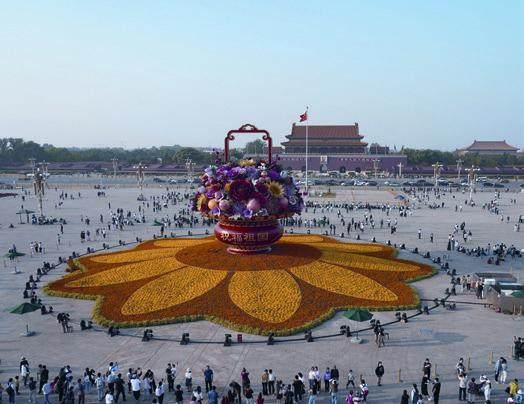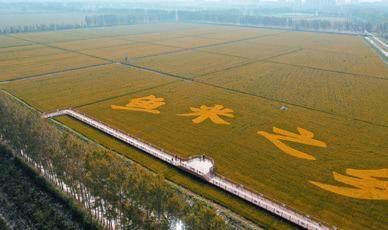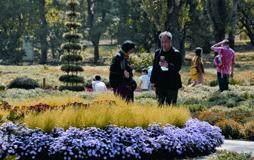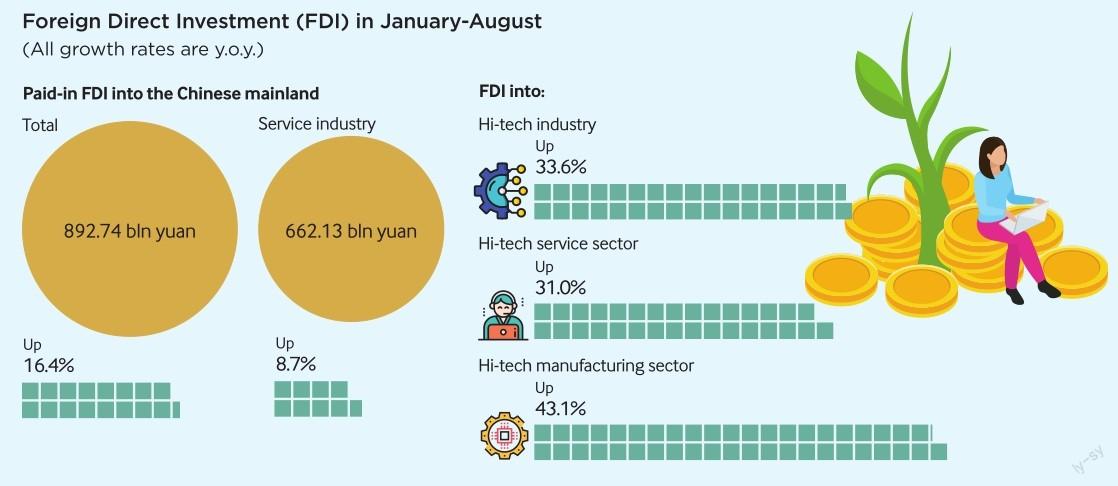FLOWER POWER
2022-05-30

In the lead-up to Chinas National Day celebrations on October 1, a huge floral arrangement themed Blessings to the Motherland is unveiled at Tiananmen Square on September 25.
An additional 14 groups of flowerbeds currently line Changan Avenue. The avenue is Beijings main thoroughfare and home to many of its most important landmarks, including Tiananmen Square and the National Museum of China.
Eco-Agriculture
Paddy fields in Dawang Town of Anxin County of Xiongan New Area, Hebei Province, on September 24. Located near Baiyangdian Lake, the largest wetland ecosystem in north China, the county has ample water for rice growing. In recent years, the county has adopted rice-fish and crab polyculture to build a modern eco-agriculture demonstration zone.

CPC National Congress Delegates
More details on the election of delegates to the 20th Communist Party of China (CPC) National Congress were unveiled after it had been announced on September 25 that all 2,296 delegates had been elected.
The electoral work, running from November 2021 through July 2022, has successfully concluded, an official of the Organization Department of the CPC Central Committee said, adding all the delegates are outstanding CPC members.
The delegates are broadly representative. A total of 771 delegates, or 33.6 percent of the total, are from the frontline. Among them, 192 are workers or migrant workers, 85 are farmers, and 266 are professionals and technicians.
The number of female delegates reached 619, or 27 percent of the total, an increase of 2.8 percentage points compared with the 19th CPC National Congress five years ago, the official said.
There are 264 ethnic minority delegates, who are from 40 ethnic minority groups.
The delegates come from various sectors of society, various administrative levels and various institutions, including Party and government departments, enterprises, public institutions and peoples organizations.
The average age of the delegates is 52.2, and about 59.7 percent of them are under 55.
About 95.4 percent of them have a diploma from junior college or above. More than half of the delegates hold a masters degree.
The official said 2,224 delegates, or 96.9 percent of the total, joined the CPC after China started its reform and openingup in 1978.
Revitalization Library
Chinese President Xi Jinping has written a foreword, titled Forging Ahead on the Journey to National Rejuvenation, for the Revitalization Library, a compilation of important literary works, which will soon be published, Xinhua News Agency reported on September 26.
In the foreword, Xi, also General Secretary of the CPC Central Committee and Chairman of the Central Military Commission, emphasized the necessity of drawing on the lessons of history, reflecting on the past, looking to the future, and pressing forward on the journey to national rejuvenation.
The compilation of the Revitalization Library is a major cultural project approved by the CPC Central Committee, Xi noted. Its publication is significant for the Chinese people to firm up confidence in history, grasp the trend of the times, follow the Chinese way, and promote the great national rejuvenation through the Chinese path to modernization.
The Revitalization Library focuses on the theme of the great rejuvenation of the Chinese nation. It features a collection of significant literature related to the great rejuvenation of the Chinese nation since the First Opium War in 1840.
Boasting five volumes in total, the Revitalization Library will see the publication of its first three volumes in the coming days.
TCM Internationalization
China has expedited the expansion of the international presence of traditional Chinese medicine(TCM) over the past decade, with the practice now spread to 196 countries and regions, according to the National Administration of TCM.
The country has facilitated the establishment of the ISO/ TC249, a technical committee within the International Organization for Standardization, which has so far issued 89 international standards for TCM, the administration said at a press conference on September 23.
China has signed specialized cooperation agreements on TCM with over 40 countries, regions and international organizations, with 30 high-quality overseas TCM centers and 75 international cooperation bases for TCM now in operation, Wu Zhendou, head of the international cooperation department of the administration, said. TCM has been incorporated into 16 free trade agreements, Wu added.
TCM has played a positive role in global COVID-19 prevention and control since the outbreak of the pandemic, according to the press conference.
Autumn Scene
Visitors tour the China National Botanical Garden in Beijing on September 25.

Autism Screening
The National Health Commission has recently released a trial protocol on autism screening and intervention services for children under the age of 6 to improve related services and safeguard the health of young children, Xinhua reported on September 23.
Due to the lack of efficacious medication, the current major treatment for children with autism is behavioral and cognitive therapy, according to experts with the commission. The optimal time for treatment is before the age of 6, and those who received science-based interventions before the age of 3 are likely to have less severe symptoms and a better prognosis, experts said.
The services will include health education, screening, diagnosis, and rehabilitation, aiming to raise parents awareness of autism, increase their willingness to have their children screened and to make use of intervention services, as well as to standardize the related services to improve the effectiveness of interventions, and reduce the occurrence of mental disability, according to the document.
Research shows that in China, the prevalence rate of autism among children has reached seven per 1,000 people.
Pollution Control
Beijing saw its primary airpollution index reading fall 20 percent year on year in the first eight months of 2022, official data showed on September 26.
The citys average concentration of PM2.5 was 28 micrograms per cubic meter in the January-August period, the Beijing Municipal Ecology and Environment Bureau said. The reading in August was 19 micrograms per cubic meter, the lowest for a single month this year.
PM2.5 readings are a gauge of airborne particles of 2.5 microns or below in diameter.
Local authorities in the city have taken numerous measures to tackle air pollution this year, including strengthening inspection of pollution sources.
From January to August, the average concentrations of PM10 and nitrogen dioxide were also down 14.5 and 16 percent year on year, respectively, the bureau added.
Intelligent Factory
The production line of a dishwasher factory opened by Chongqing Haier Washing Electric Appliances Co. Ltd. in Chongqing on September 25. This 42,000-square-meter factory, with a designed annual output of 1 million dishwashers, utilizes advanced technologies like 5G and industrial Internet.

Harvest Festival
China celebrated the Fifth Chinese Farmers Harvest Festival in Beijing and the southwestern city of Chengdu in Sichuan Province on September 23.
Farming-themed activities, including product and agricultural technology exhibitions and farming awards ceremonies, were hosted at the two venues of this years harvest festival celebration, attracting public participation.
Initiated in 2018, the festival coincides with the autumnal equinox each year. The autumnal equinox is one of the 24 solar terms in the Chinese lunar calendar and it usually falls between September 22 and 24, during the countrys agricultural harvest season.
Bond Market
The bond market is playing a growing role in serving the real economy, data from the central bank showed.
By late August, the balance of various bonds in China totaled 142.3 trillion yuan ($20.24 trillion), the second highest globally, according to the Peoples Bank of China.
The countrys direct financing volume has expanded thanks to the development of the bond market. Net bond financing accounted for 31 percent of the countrys total social financing by late August, up 10 percentage points from the same period in 2017.
With a balance of 32.2 trillion yuan ($4.58 trillion) by late August, corporate credit bonds have become the second largest financing channel of the real economy, after credit loans, boasting lower costs than the latter in general.
Bond types have also been enriched. The balance of local government bonds stood at 34.6 trillion yuan ($4.92 trillion) by late August, making it the most significant variety in Chinas bond market.
Fixed Assets Investment
Fixed assets investment (FAI) grew at an average annual rate of 9.4 percent from 2013 to 2021, sustaining a steady expansion and boosting economic development, according to a report released by the National Bureau of Statistics.
Accumulative investment in fixed assets in the country totaled 409 trillion yuan ($58.5 trillion) in the period.
In 2021 alone, Chinas FAI reached 55.3 trillion yuan ($7.7 trillion), compared with 28.2 trillion yuan ($3.9 trillion) in 2012.
Infrastructure investment saw steady growth, registering an average annual growth rate of 12 percent in the decade, 2.3 percentage points higher than that of the total FAI, according to the report.
The real estate sector attracted a total of 103 trillion yuan($14.4 trillion) worth of funds in the period, with an average annual growth rate of 9.2 percent.
The report also highlighted the stronger role of investment in nurturing new growth drivers. Funds flowing into scientific research and technology services maintained rapid growth, increasing at an annual rate of 12.1 percent from 2012 to 2021.
Green investment has become a new trend amid the countrys pursuit of low-carbon development, with investment in ecological protection and environmental governance rising 22.7 percent annually, the report stated.
Expo Results
The Seventh China-Eurasia Expo concluded in Urumqi, capital of Xinjiang Uygur Autonomous Region, on September 22, reporting fruitful cooperation outcomes, according to its organizer.
The expo gathered 864 enterprises from home and abroad at its offline events, with 3,597 companies from 32 countries and regions participating online.
Sideline events including three performances were organized online to further peopleto-people exchanges between China and other Eurasian countries.
The expos online platform will continue to provide free services for registered businesses to host investment and promotion activities for one year, the organizer said.
Outbound Direct Investment
Chinas non-financial outbound direct investment (ODI) reached 492.76 billion yuan ($69.1 billion) in the first eight months of the year, up 7.2 percent year on year, official data showed.
In U.S. dollar terms, the ODI rose 5.8 percent from a year ago, according to the Ministry of Commerce.
Outbound leasing and business services investment rose 25.1 percent from a year earlier to $25.13 billion.
Investment in multiple fields, including wholesale and retail, manufacturing, construction, as well as scientific research and technical services registered growth.
In the first eight months, non-financial direct investment into other countries participating in the Belt and Road Initiative increased 8.2 percent year on year to $13.95 billion.
Renminbi Global Payment
The Chinese currency, known as the renminbi or the yuan, saw its share in global payments rise for a fourth straight month in August, a report stated.
The yuans global share was up from 2.2 percent in July to 2.31 percent last month, according to the Society for Worldwide Interbank Financial Telecommunication, a global provider of financial messaging services. The currency remained the worlds fifth most active currency.
In August, the value of renminbi payments gained 9.25 percent over the previous month, higher than the 4.01-percent increase in the value of payments in all currencies.
In terms of international payments, excluding the eurozone, the renminbi continued to rank sixth with a share of 1.55 percent.
Industrial Clusters
The development of Chinas industrial clusters accelerated recently, with the output value of 25 advanced manufacturing clusters growing steadily in the first half of the year, Wang Wei, an official with the Ministry of Industry and Information Technology, told a press conference on September 23.
The 25 advanced manufacturing clusters generated an output value of 6.2 trillion yuan($886.73 billion) in the period, rising 6.1 percent from the same period last year.
These clusters encompass more than 1,000 “little giant”companies, representatives of the novel elites of Chinas small and medium-sized enterprises that specialize in a niche market, boast cutting-edge technologies and show great potential.
China has established 445 national-level demonstration zones for new industrialization based on previous development zones and industrial parks, according to Wang.
The demonstration zones have contributed nearly 30 percent of the countrys total value-added industrial output and more than 30 percent of its imports and exports, serving as a driving force in promoting high-quality development of the regional manufacturing sector, data from the ministry showed.
Vehicle Sales
Some 1.03 million Chinese-brand passenger vehicles were sold in August, surging 45.3 percent year on year and accounting for 48.4 percent of the countrys total passenger car sales, data from the China Association of Automobile Manufacturers showed.
In the first eight months of this year, sales of domestic auto brands rose 24.5 percent year on year to near 7 million units, accounting for 47.8 percent of Chinas total passenger car sales in the period and up 4.9 percentage points from the same period in 2021.
In the niche sport utility vehicle category, the market share occupied by Chinese brands rose to 52.3 percent in August and 54.4 percent in the JanuaryAugust period, the association said.
NUMBERS
($1=7.07 yuan as of September 27)


